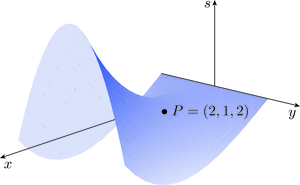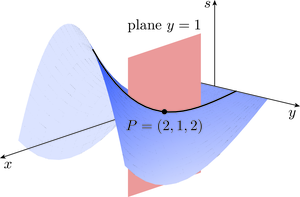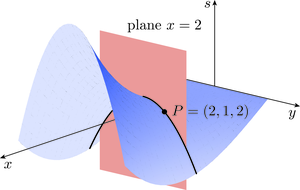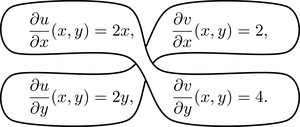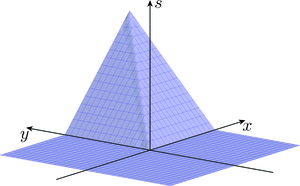2.1 The Cauchy–Riemann theorems
Here we will explore the relationship between complex differentiation and real differentiation. To do this, we introduce the notion of a partial derivative and use it to derive the Cauchy–Riemann equations (pronounced ‘coh-she ree-man’). These equations are conditions that any differentiable complex function must satisfy, so they can be used to test whether a given complex function is differentiable. In particular, we use them to investigate the differentiability of the complex exponential function. The technique is to split the exponential function
into its real and imaginary parts:
each of which is a real-valued function of the real variables and . The derivative of exp is then calculated by using the derivatives of the real trigonometric and exponential functions, which we assume to be known.
Before we deal with the exponential function, however, let us first consider the simpler function . By writing , we see that
Let us define
Then and are the real and imaginary parts of , respectively; that is, and . For the moment we will concentrate on the real part ; part of its graph (given by the equation ) is shown in Figure 9. Since is a function of two real variables, its graph is a surface. The height of the surface above the -plane represents the value of the function at the point . For instance, the point on the surface has coordinates because .
Let us now explore the concept of the gradient of the surface at a point such as . We will find that the answer depends on the ‘direction’ from which we approach the point. To make this more precise, consider Figure 10, in which the vertical plane with equation is shown intersecting the surface in a curve that passes through . By substituting into , we see that the curve has equation , so we can calculate its gradient at ; this is the gradient of the surface in the -direction at .
More generally, whenever we intersect the surface with a vertical plane with equation , we obtain a curve on the surface with equation (where is considered to be fixed). We can find the gradient at any point on this curve by differentiating with respect to and then substituting and . The resulting expression is called the partial derivative of with respect to at , and it is denoted by
A curly is used rather than a straight to emphasise that this is a partial derivative, for which we differentiate with respect to one variable and keep the other variable fixed. In our particular case, differentiating with respect to (and keeping fixed) gives
and substituting and gives
Hence the gradient of the surface in the -direction at the point is 9. This is a positive value because near the point , increases as increases (with ), as you can see from Figure 10.
Figure 11 shows the vertical plane with equation intersecting the surface in a different curve that passes through .
Reasoning similarly to before, we see that intersecting the surface with a vertical plane with equation gives a curve on the surface, and we can obtain the gradient at a point on this curve by differentiating with respect to while keeping fixed (and then substituting and ). The resulting expression is called the partial derivative of with respect to at , and it is denoted by
Differentiating with respect to (and keeping fixed) gives
this is the gradient of the surface in the -direction at the point . It is a negative value this time, because when and are positive, decreases as increases (keeping fixed), as you can see from Figure 11.
You will need to work with partial derivatives a good deal here, so let us state the definitions formally.
Definitions
Let be a function with domain a subset of that contains the point .
The partial derivative of with respect to at , denoted , is the derivative of the function at , provided that this derivative exists.
The partial derivative of with respect to at , denoted , is the derivative of the function at , provided that this derivative exists.
Partial derivatives are real derivatives, not complex derivatives.
The next exercise asks you to work out the partial derivatives of the imaginary part of the complex function .
Exercise 16
a.Calculate the partial derivatives of .
b.Evaluate these partial derivatives at .
Answer
a.Differentiating with respect to while keeping fixed, we obtain
Differentiating with respect to while keeping fixed, we obtain
b.So, at the partial derivatives have the values
Let us collect together the partial derivatives of the real and imaginary parts and of the function :
As you can see, we have
This pair of equations is called the Cauchy–Riemann equations, and they hold true for the real and imaginary parts of any differentiable complex function, as the following important theorem testifies.
Theorem 4 Cauchy–Riemann Theorem
Let be defined on a region containing .
If is differentiable at , then , , , exist at and satisfy the Cauchy–Riemann equations
Proof
Let . Suppose that is any sequence in that converges to . Let us write . According to the definition of a derivative, we haveObserve that, by expressing in terms of its real and imaginary parts, we can write
We proceed by choosing two different types of sequences , and observing the behaviour of the expressions in large brackets in equation 3 (above) in each case.
For our first choice, let us begin by defining to be any sequence in that converges to . Let , so the sequence converges to . By removing a finite number of terms from , if need be, we can assume that each point belongs to the open set . Substituting into equation 3 gives
We know that the expression on the left-hand side converges (to ), so its real and imaginary parts (indicated by the bracketed expressions on the right-hand side) converge too. Since was chosen to be any sequence in that converges to , we see from the definition of partial derivatives that and exist at and
In summary, we have
Next let be any sequence in that converges to , and define , so . Again, by omitting a finite number of terms from , if need be, we can assume that for all . Substituting into equation 3 gives
Reasoning as before, we see that and exist at and
Origin of the Cauchy–Riemann equations
The Cauchy–Riemann equations are named after the mathematicians Augustin-Louis Cauchy and Bernhard Riemann (1826–1866), who were among the first to recognise the importance of these equations in complex analysis.
The Cauchy–Riemann equations first appeared in the work of another mathematician, however: the Frenchman Jean le Rond d’Alembert (1717–1783), who is perhaps best remembered for his work in classical mechanics. Indeed, the Cauchy–Riemann equations were written down by d’Alembert in an essay on fluid dynamics in 1752 to describe the velocity components of a two-dimensional irrotational fluid flow.
The Cauchy–Riemann Theorem gives us another strategy for proving the non-differentiability of a complex function. (Two other strategies were described earlier in Section 1.3.) If a complex function is differentiable, then it must satisfy the Cauchy–Riemann equations. So if those equations do not hold, then the function cannot be differentiable.
Strategy C for non-differentiability
Let . If either
then is not differentiable at .
To illustrate this strategy, consider the function
The real part and imaginary part of this function are given by
Hence
As you can see, the partial derivatives have been grouped into two pairs according to the Cauchy–Riemann equations.
In this case, these equations are and , which are satisfied only when and ; that is, they are satisfied only when . If , then the Cauchy–Riemann equations fail, so Strategy C tells us that is not differentiable at .
Notice that the Cauchy–Riemann Theorem and Strategy C do not tell us whether is differentiable at the point at which the Cauchy–Riemann equations are satisfied. To deal with points of this type we need another theorem, which we will come to shortly. First, however, try the following exercise, to practise applying Strategy C.
Exercise 17
Show that each of the following functions fails to be differentiable at all points of .
a.
b.
Answer
a.Writing in the form
we obtain
Hence
Since is always positive, whereas is always negative, the first of the Cauchy–Riemann equations fails to hold for each . It follows that fails to be differentiable at all points of .
b.Writing in the form
we obtain
Hence
It follows that the first of the Cauchy–Riemann equations fails to hold for each , so fails to be differentiable at all points of .
We have seen that if the Cauchy–Riemann equations are not satisfied, then the function is not differentiable. Let us now describe an example to show that even if the Cauchy–Riemann equations are satisfied, then the function may still not be differentiable.
Consider the function , where for all and , and
The graph of is shown in Figure 12.
Since and take the value at all points on the - and -axes, we see that all the partial derivatives vanish at ; that is,
However, even though the Cauchy–Riemann equations are satisfied at the origin, is not differentiable there. To see this, observe that if , , then
whereas if , , then
The two limits and differ, so is not differentiable at .
This example demonstrates that the differentiability of a complex function does not follow from the Cauchy–Riemann equations alone. However, if certain extra conditions are satisfied, then is differentiable, as the following theorem reveals.
Theorem 5 Cauchy–Riemann Converse Theorem
Let be defined on a region containing . If the partial derivatives , , ,
exist at for each
are continuous at
satisfy the Cauchy–Riemann equations at ,
then is differentiable at and
The proof of this theorem is postponed until the next subsection.
Let us now return to the function , considered earlier, which satisfies the Cauchy–Riemann equations at the point only, and is therefore not differentiable at any other point. You saw earlier that the partial derivatives exist for every point (so we can choose in applying Theorem 5) and they satisfy
Each of these functions is continuous at because each of them is either constant or a multiple of one of the basic continuous functions or . For example, the function can be thought of as .
It follows, then, from the Cauchy–Riemann Converse Theorem that is differentiable at . In fact, the theorem even tells us the value of , namely
Now, we investigate the differentiability of the complex exponential function, as promised earlier.
Example 8
Prove that the complex exponential function is entire, and find its derivative.
Solution
The real part and the imaginary part of are given by
Hence the partial derivatives of and exist for every point and satisfy
Since the real exponential and trigonometric functions are continuous, and the real and imaginary part functions and are basic continuous functions, we see from the Combination Rules and Composition Rule for continuous functions that each partial derivative is continuous at every point .
The Cauchy–Riemann equations are satisfied at all points , so the Cauchy–Riemann Converse Theorem tells us that is differentiable at every point of the complex plane (it is entire) and
Exercise 18
Use the Cauchy–Riemann theorems to find the derivatives of the following functions. In each case specify the domain of the derivative.
a.
b.
(Hint: For part (a), write and use a trigonometric addition identity to find the real and imaginary parts of .)
Answer
a.From the trigonometric identities,
so , where
Hence
These partial derivatives are defined and continuous on the whole of . Furthermore,
so the Cauchy–Riemann equations are satisfied at every point of .
By the Cauchy–Riemann Converse Theorem, is entire, and
Hence has domain and .
b.Here , so
Hence
The Cauchy–Riemann equations cannot be satisfied unless and , so fails to be differentiable at all non-zero points of .
However, the Cauchy–Riemann equations are satisfied at , and the partial derivatives are defined on and continuous (at ), so by the Cauchy–Riemann Converse Theorem, is differentiable at , and
Thus has domain and .
(This is the example referred to in Section 1.1 of a function that is differentiable at a point, but not analytic at that point.)

